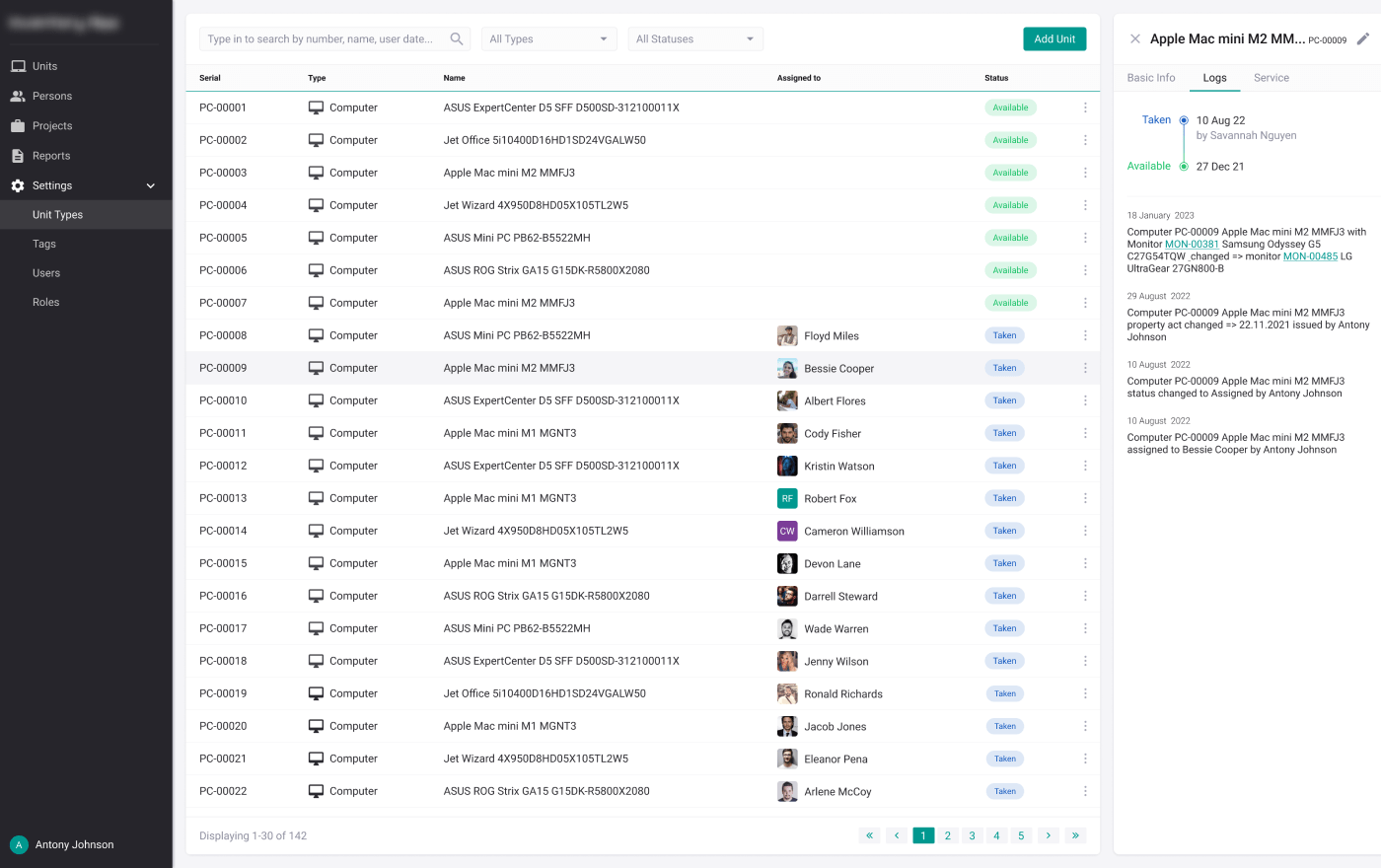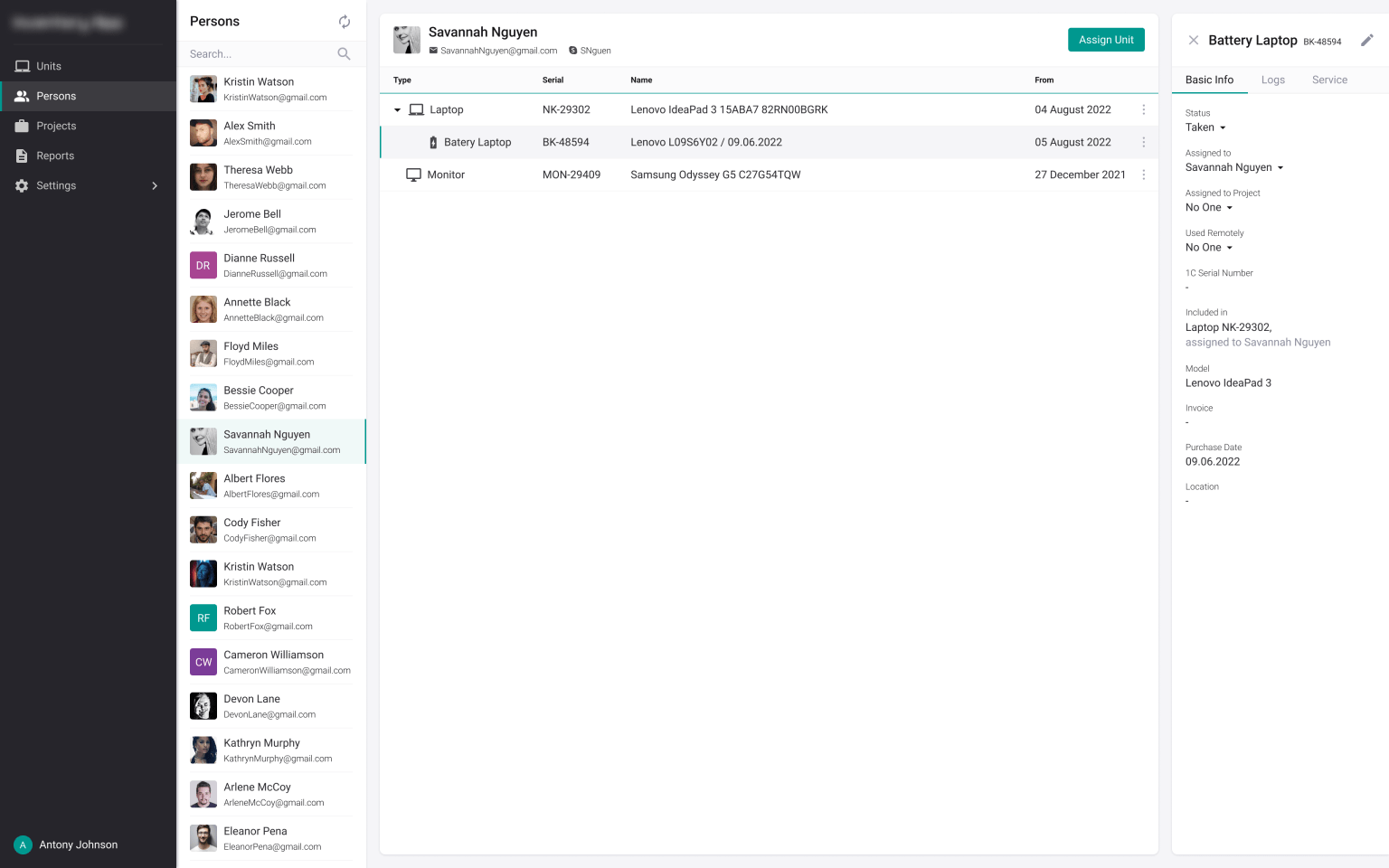Warehouse and Inventory Management System
Warehouse management system that helps to manage the technical inventory of small- to medium-sized companies. A better alternative to Microsoft Excel Spreadsheet and Google Sheets when you don’t want to bother your team with unnecessary features but have access to the relevant data.

Business Challenge
As any other business, we need to deal with various processes, and having control over our company’s inventory is one of them. When you have 10 people, maybe 20, or 30, using Microsoft Excel Spreadsheet or Google Sheets may be a good start. Those are the options we used as well. However, after a company begins to grow, the amount of needs a team may have increases. As time went by, we understood that something more sophisticated would be better to have in our use.
Being a custom web development company, we decided to solve the issues by creating a custom warehouse management system (WMS), because it became impossible to include details provided by 200+ employees into one spreadsheet. In order to develop the best solution, our dev team considered the following:
- Our system administrator longed for having an up-to-date list of available equipment and the one that was handed out. They also offered to implement the feature that helps them to see the list of inventory equipment given to a specific employee at the moment;
- The financial department needed the input to prepare documents for the legal procedure of inventory count and be able to gather yearly statistics of inventory shortage or overstock;
- In general, all employees wanted to have as little headache as possible and just use the equipment they need for their everyday tasks.
Our team already had a running system of internal reporting, where all the data on employees and projects was stored. The new inventory management application was supposed to be synchronized with this system. Thus, changing the list of employees once should have updated the information in all connected places at the same time.
Solution
At first, we searched for available third-party WMS solutions. There are plenty of web applications for warehouse management, from the bulky ones created for manufacturing companies to simple equipment management solutions developed specifically for the IT sector. Our specialists were studying two key possibilities for each option:
- exporting customizable Excel spreadsheets to use for mandatory reports;
- potential integration with our internal reporting system.
Taking these requirements into account, we did not find an optimal solution. Some systems were too loaded with unnecessary features, others did not have needed reporting capabilities. There were also those that simply required so much time to adapt them to our needs that it was easier to write our own application. We already had a database of employees, knew our stakeholders’ requirements, and could implement all the legal constraints correctly. Our team could also make the future warehouse management software flexible, so that when change requests arise, it would be easier to add them to the system.
To figure out how all the criteria should be met, our development team decided to use our own product, Webix JavaScript UI library. It was the best option to use for front-end development. We needed a simple and clear UI with lots of lists and tables, so Webix was an ideal choice for our goals. As for the back-end development process, our experts selected Koa.JS and MySQL.
To perform the warehouse management software development the way our team needed, we added useful core features.
The list of tech equipment
The developers added the up-to-date list that shows equipment that is available for users and the one that is currently in use. Thus, we can view all technical specifications and change the availability of equipment with a few clicks.
The list of employees and projects
The equipment can be assigned either to an employee or to a project (e.g. a test device for QA). An administrator can open the card of each employee/project and see the list of the equipment currently assigned to them.
General statistics
The system has a nice and simple dashboard to check how many pieces of each type of equipment are now available or need to be repaired.
Data synchronization
The app takes all data on employees and current projects from the reporting system we use.
LDAP protocol for logging in
All our internal services, including reporting software, warehouse management system, and a few other apps use the same authorization system. It means that you don’t need to remember dozens of access credentials.
Export to Excel
An administrator can get an Excel file perfectly tuned to legal requirements at any moment.
To make our system administrators’ daily work more convenient, we also ensured that the WMS software has the following features:
- Equipment hierarchy;
- Adding equipment in bulk;
- Employee email & Skype login.
Implemented Components
While providing custom software development services, we have also developed our own products. So, it wouldn’t be a surprise for us to use some of them, because they allow us to significantly improve the development process and increase its speed. All employees needed to see the list of equipment, their statuses, and be able to search for the needed records, create new ones, or filter the requested data. To fulfill the team’s needs and meet these and other requirements, the dev team chose several Webix widgets to have the features we wanted.
Webix User Manager is one of the modules that our team integrated. The module suited perfectly, because you can easily keep record of the equipment, check the maintenance status, usage history, and track all other actions related to users and equipment. This ready-made user management solution can be customized, which helped us to find the look we wanted, and provides easy backend integration to reduce time and resources spent on the development process.
Among other widgets, Webix JavaScript Report manager is another tool that was used. With its help, it is possible to get the needed equipment statistics faster and in a more intuitive manner. Our goal was to save time and avoid unnecessary costs, so this elaborate option helped us to deal with big volumes of data and create reports more efficiently. Considering that it is a cross-platform solution that also supports all modern browsers, we are able to work with the warehouse management system from different devices.
Project in Figures
Duration
man-hours

Applied Technologies




Result
Our team has been using our application for several years now, occasionally adding a few tweaks here and there, because both technologies and the skills of our specialists don’t stop evolving. We are happy with the results, because it is a lot easier for us to control the company’s inventory and manage users to help employees in their daily tasks.